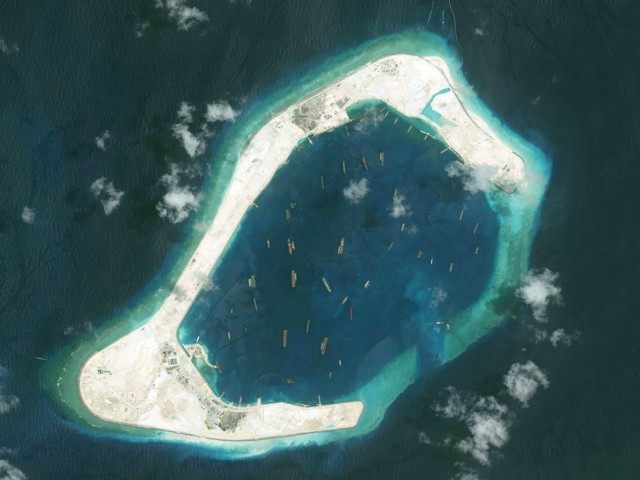U.S. Director of National Intelligence James Clapper said today he expects the Chinese government to continue its illegal construction of artificial islands in the South China Sea, as propaganda in Chinese media becomes increasingly vocal in support of efforts to cement the nation’s hold over the region.
Speaking before Congress today, Clapper described China’s claims in the South China Sea as “exorbitant,” but nonetheless predicted that China will continue its construction of artificial islands and military facilities in the Spratly and Paracel Islands. He noted that, during a visit to China last year, Chinese President Xi Jinping had assured him that the artificial islands were meant for civilian purposes.
China has completed the construction of an airplane landing strip in the Spratly Islands and appears to be constructing three more. The airstrips will allow surveillance planes to land and refuel in the islands, giving China the ability to easily control everything transiting through the region.
China has begun construction in regions of the South China Sea whose sovereignty is variously disputed by Taiwan, Brunei, Malaysia, Vietnam, and the Philippines. The Philippines and Taiwan both claim the Spratly Islands, while Vietnam and the Philippines each claim part of the Paracel Islands.
An article in the Asia Times notes that, in the days preceding Clapper’s warning, Chinese state media appears to have escalated its propaganda efforts in claiming the Spratly and Paracel Islands for China. The editorials calling for more Chinese control of the region follow an American “freedom of navigation” exercise near the Paracel Islands. The USS Curtis Wilbur, a missile destroyer, transited within 12 miles of Triton Island, in the Paracels, on January 30, without warning China that it would be in the area.
The United States Department of Defense made clear that the operation was intended to challenge any unilateral claim to navigating the Paracel Islands, something Chinese state media strongly objected to, though the Chinese Foreign Ministry issued a tepid official statement: “China has indisputable sovereignty over islands in the South China Sea and their adjacent waters.”
In China’s Global Times, the Asia Times piece notes, a senior colonel of the People’s Liberation Army demanded that China establish an Air Defense Identification Zone (ADIZ) over the South China Sea, calling for China to build up a military presence in the region “as soon as possible.” An ADIZ would require any air traffic in the entire sea to identify itself to the Chinese military or face military consequences. China imposed an ADIZ over Japanese waters in the East China Sea in 2013, though it has been unable to successfully impose the policy in the region.
In China’s People’s Daily, Foreign Ministry spokesman Lu Kang described freedom of navigation exercises as an “infringement of China’s sovereignty,” with the article itself claiming the United States is seeking “maritime hegemony” in the region by maintaining a navigational presence. As The Diplomat notes, however, China has been careful not to make any concrete legal claims regarding where its borders end in the South China Sea:
Article 16 of the United Nations Law of the Sea requires states to publicize their claimed territorial seas and baselines (boundaries that maritime claims are measured from) and provide them to the UN either on “charts… adequate for ascertaining their position” or in a “list of geographical coordinates of points.” But for all the contentiousness, China’s deposits to the UN contain few such explicit claims.
The claims known as the “five-dash line,” in which China claims control of the Spratly and Paracel archipelagos, comes from a note verbale that China sent to the UN with a map detailing their claims, a document that is in no way legally binding, The Diplomat notes.
Despite this, Chinese media have campaigned strongly for the past year arguing the maritime borders favor their position. And, Nikkei reports, this has led to an increase in military development throughout the region. Asia, the publication notes, was the only region to increase military spending in 2015, with both China and the Philippines increasing their military spending by 11% and 10%, respectively.

COMMENTS
Please let us know if you're having issues with commenting.